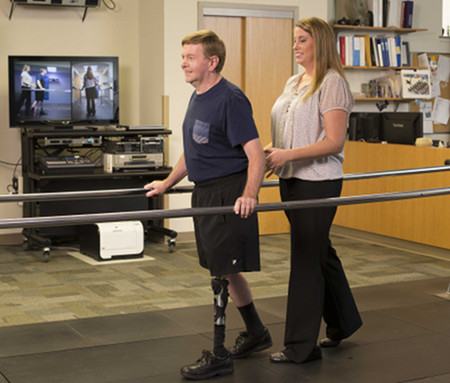
(Inside MossRehab/Winter 2015) - Underpinning the best amputation care and prosthetic management for patients is continuous research to improve prosthetic functionality and being able to better predict patient response to specific interventions. Mukul Talaty, PhD, a biomechanist at MossRehab,is working on two research projects that are making significant headway toward these ever-evolving goals.
Project 1: Force-line VisualizationTechnology to Enhance Prosthetic Alignment
“Force-line visualization is a technique that was developed here at MossRehab back in the 1970s and 80s when it was a federally funded Rehabilitation Engineering Center,” says Dr. Talaty. “It allows us to literally see the forces acting under the foot as someone walks.”
By using force-line visualization, a clinician can easily spot gait abnormalities and quickly make adjustments to prostheses. The original version of this technology, and the version currently used in the lab, is analog. A few years ago, MossRehab researchers worked with an industry partner to develop a digital version.
“Together with Bertec Corp., we obtained a National Institutes of Health grant to study how this could be used to train novice clinicians,” says Dr. Talaty. “We demonstrated that using this technology, along with some simple verbal and hands-on demonstrations, allows novice clinicians to achieve alignment outcomes similar to that of highly experienced clinicians.”
This research is important because variability of functional walking outcomes in prosthetics due to alignment is one of the major areas that lacks proper scientific investigation and evidence-based rules.
“It has been a long-term goal of ours to infuse objectivity into prosthetics education and clinical processes,” says Dr. Talaty. “To that end, Dr. Esquenazi and I presented two workshops at this year’s American Academy of Physical Medicine and Rehabilitation Annual Meeting in San Diego, where we demonstrated the use of the force-line to understand and improve prosthetic alignment.”
MossRehab researchers continue to work with industry partners to determine how to further develop this technology—making it more accurate, portable, affordable and accessible to facilities that provide prosthetic services—and how to teach clinicians to properly use it.
“A major obstacle is acquiring sufficient funding to continue to move this research forward quickly and with maximal impact,” Dr. Talaty says.
Project 2: Computer Simulation to ExploreProsthetic Function and Outcomes
A relatively newer project that branches from Dr. Talaty’s ongoing work in computer simulation uses physics-based models to synthesize human walking in a new way.
“We can use computer models as a platform to understand how people walk and how interventions may affect walking performance,” says Dr. Talaty. “Our model is a neuromusculoskeletal model, with elements of neural control: neural control loops, feed-forward and feedback elements, mathematical equations to codify basic neural principles such as reflexes and reciprocal inhibition. It also includes elements of muscle control: how they contract when neurally excited, how much force they produce, how bones are connected and more. This is combined with pure physics equations that govern how bodies move.”
Dr. Talaty has developed this computer model with the help of other scientists and several graduate students, and it’s now able to simulate normal and pathological walking in a manner very similar to that of real people.
“It captures many of the salient kinematic and kinetic features of walking,” says Dr. Talaty. “We have begun to explore how it can teach us how walking is influenced by interventions. Ultimately, it may be able to be configured to model individual patients and their gait problems and then used to predict how each specific patient would respond to specific interventions. In the meantime, there is much we can do with such a powerful platform.”
Last summer, Dr. Talaty worked with an undergraduate engineering intern who had an interest in prosthetics. Together, they “amputated” the foot and lower leg of the computer model and gave it a prosthesis that represented a currently used prosthetic device.
“That the model was even able to walk after this was no small feat and speaks to the robustness of the neural control scheme we have embedded,” says Dr. Talaty.“We then altered the alignment of that prosthesis and measured how the walking performance of the model changed. We are in the process of comparing that response to the response of people with amputation.”
The key is determining if the model responds in a similar enough manner to the actual system it is designed to mimic, he says. “Validation would obviously be a pre-cursor to meeting patient-specific needs.”